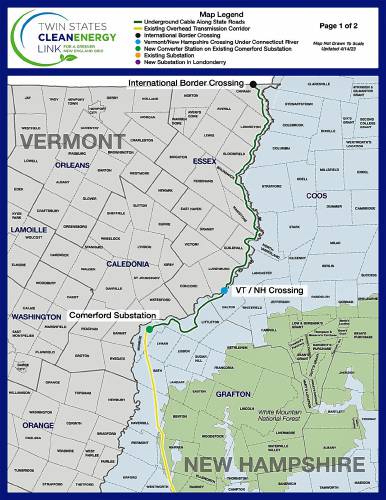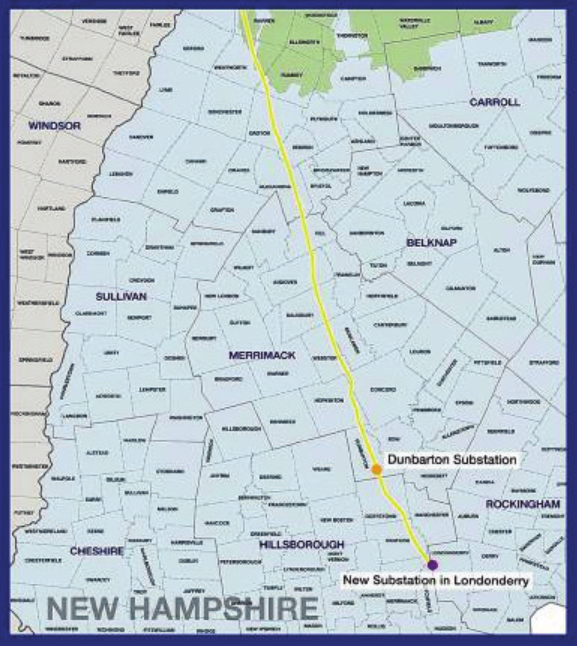Five years after Northern Pass was rejected by the state, another proposal is on the books to bring Quebec hydropower through New Hampshire, but this time along a different route — passing through Dunbarton instead of Concord — with different owners and a different financial setup.
The 211-mile proposal, about 135 miles of which is in New Hampshire, was put together by National Grid and Citizens Energy Corporation. Like Northern Pass, it would carry more than 1,000 megawatts of electricity into New England from the massive hydropower dams owned by Hydro-Quebec. But it avoids the most contentious parts of the earlier Eversource proposal by skirting the White Mountain National Forest, burying all new lines, and using National Grid’s existing rights-of-way in New Hampshire without apparently needing to build new towers. Construction couldn’t start until 2026 at the earliest, since a number of permits are needed.
The proposal, called Twin States Clean Energy, comes as work has started on an unrelated power line down the Hudson River that will carry electricity from Hydro-Quebec to New York City, and one week after a jury resurrected a proposal to carry Quebec hydropower into New England through Maine. The Maine plan was created after New Hampshire shot down Northern Pass in 2018.
Adding more hydropower to the Northeastern power grid has long been advocated for environmental and cost reasons, since electricity made by dams is cleaner and often cheaper than electricity made by fuel-burning plants, but has been thwarted by opposition to new transmission towers and lines needed to carry it.
National Grid is applying to be part of the U.S. Department of Energy’s Transmission Facilitation Program, which is trying to build more large-scale projects.
The Twin State Clean Energy website says it “utilizes existing transmission corridors in New Hampshire and buries new lines along state roadways in both states.” That could minimize opposition that helped kill Northern Pass, which struggled for almost a decade to get approval over North Country opposition before the state Site Evaluation Committee nixed it in 2018.
As described by the developers, the high-voltage DC line would cross from Canada into northern Vermont and come south along the Connecticut River in that state before crossing under the river to the New Hampshire town of Dalton. It would go underground along Route 135 for 26 miles to Monroe, where it would use a rebuilt converter station and then travel above-ground on existing National Grid transmission rights of way to the substation in Dunbarton, which would have to be upgraded.
From Dunbarton, it would follow existing rights-of-way down to Londonderry and hook into the region’s grid.
The project has been put before the Energy Department, which is leading the Biden administration’s efforts to get more transmission lines built as a way to strengthen the grid. It has the backing of Gov. Chris Sununu.

The northern portion of the proposed Twin States Clean Energy power line bringing Quebec hydropower into Vermont, and crossing underneath the Connecticut River to the NH town of Dalton. From Dalton to Monroe, new underground lines would be placed; at Monroe it would go above-ground to an existing transmission corridor. The southern portion of the proposed Twin States Clean Energy power line traveling along an existing National Grid right-of-way. An existing substation in Dunbarton would be upgraded. (Twin States Clean Energy)

Northern Pass differences
Like Northern Pass, the proposal would cost a couple of billion dollars to build, and carry about as much electricity as Seabrook Station can generate into the New England grid.
Unlike Northern Pass, which would have been owned by a separate, shareholderfunded arm of Eversource, it appears that the Twin State Clean Energy developers plan to cover costs through electricity rates, as is done with most power lines. The website says it “will be paid for by the energy companies that deliver energy over the line.”
The news of the proposal came shortly after a jury ruling brought back to life a proposal to build a 1,220-megawatt power line from Quebec into Maine, where it would feed into the six-state New England grid. That project was stalled after a 2021 referendum opposed the idea but appears to be on track again.
Work began in December on the 1,250-megawatt Champlain Hudson Power Express, which will travel down Vermont’s western border to New York City, bypassing the New England grid.
Putting high-voltage DC lines in existing transmission routes doesn’t always placate critics, because sometimes it means building larger towers and widening the transmission corridor since far more voltage is being carried. However, the FAQ from Twin States claims that from Monroe to Litchfield it “would simply need to reconductor the existing transmission lines, while replacing a small portion of them due to condition or to provide the appropriate clearance for the new wires.”
The final 2.5 miles to Londonderry will require “reconfigurations” terminating at a new substation, the FAQ said.
Another difference from Northern Pass and many transmission lines is that Twin States would be bidirectional, with “the ability to move power in both directions, importing hydropower from Canada to New England and exporting excess renewable power from New England to Canada.” That would provide a level of extra flexibility to help balance the future needs of the power grid as more renewable energy from wind and solar replaces gas-fired power plants.
This article is being shared by partners in the Granite State News Collaborative. For more information, visit collaborativenh.org.